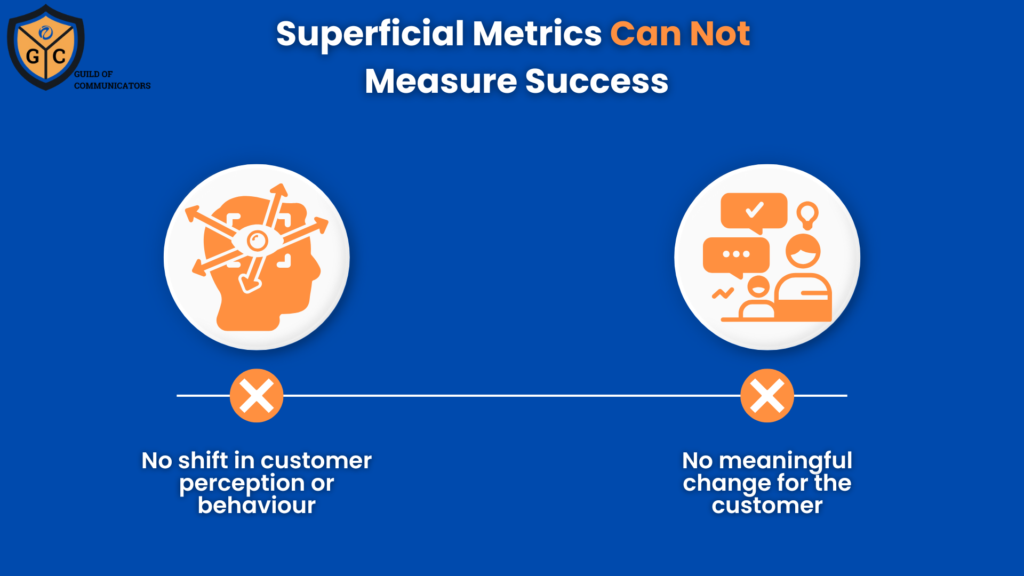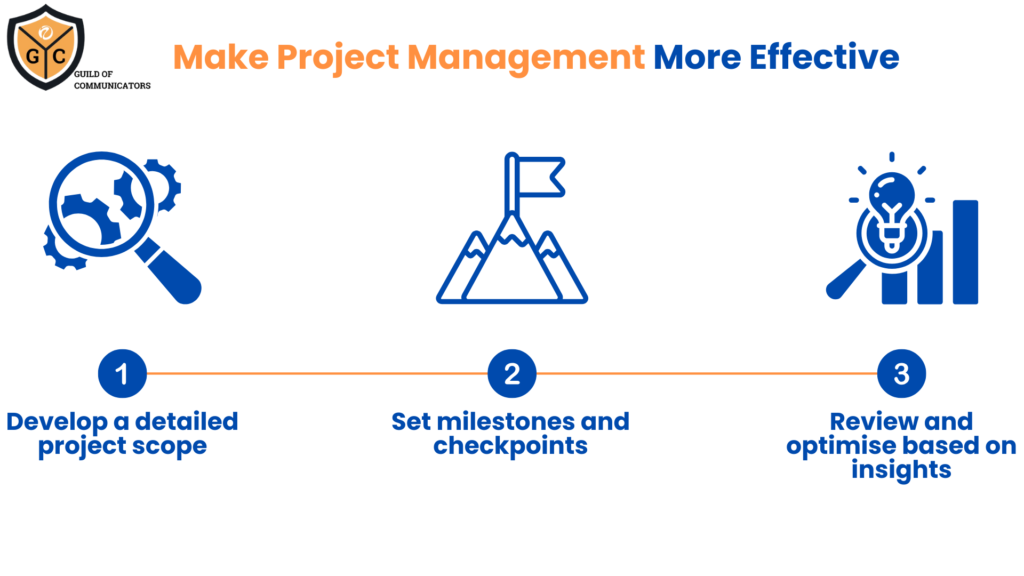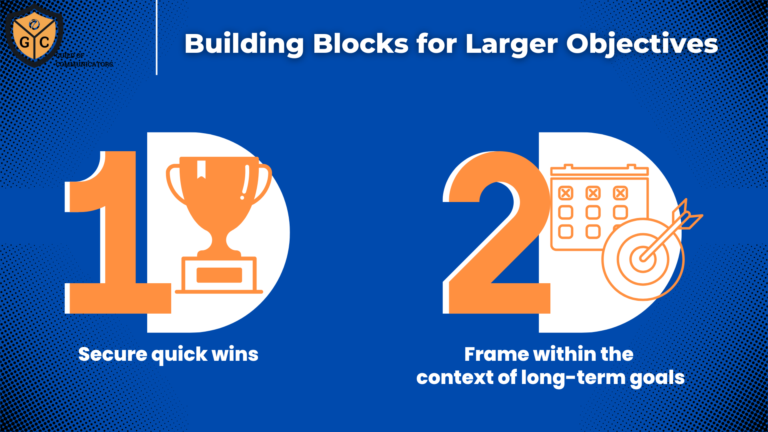Communicators often find themselves chasing short-term outputs dictated by leadership.
While these outputs may provide a sense of accomplishment, they do not always contribute to meaningful progress.
Without a structured approach to project management, communicators risk focusing on activities that generate immediate results but fail to create lasting impact.
The Problem with Prioritising Activity Over Impact
Hitting short-term outputs may feel rewarding, but it does not necessarily bring a brand closer to influencing its audience. Many communicators rely on superficial metrics—such as media coverage volume, social media engagement, or event attendance—to measure success.
However, these indicators do not always translate into tangible shifts in customer perception or behaviour. When communication efforts focus purely on execution without considering the bigger picture, the opportunity to drive meaningful change is lost.
A fixation on immediate results can lead to disjointed efforts. Teams may launch multiple disconnected initiatives that generate buzz but lack cohesion and strategic intent. This fragmented approach diminishes the ability to build long-term credibility and trust with audiences. Instead of reinforcing a consistent brand narrative, it creates noise that can be easily ignored.
Additionally, prioritising activity over impact can exhaust resources without delivering meaningful outcomes. Communicators often work under tight deadlines, and without a clear focus on long-term goals, they may expend effort on tasks that do not align with broader business objectives. This misalignment reduces the effectiveness of campaigns and weakens the overall value of the communications function.

What Every Communication Programme Needs to Succeed
To ensure communication initiatives contribute to broader business objectives, project management should include:
- A clear mandate and brief on outcomes – Understanding what success looks like and aligning the communication programme with organisational goals.
- A strong strategy and approach – Defining the key messaging, target audience, and channels that will drive meaningful engagement.
- A robust execution agenda and action plan – Detailing the steps, responsibilities, and timelines required to implement the strategy effectively.
- A clear way to measure outputs that lead to outcomes – Establishing metrics that track both execution efficiency and real impact on the audience.
A well-defined mandate ensures that all stakeholders have a shared understanding of the campaign’s purpose. When objectives are ambiguous, teams may struggle to deliver cohesive messaging or fail to prioritise tasks effectively. Clear outcomes provide direction and help measure whether efforts are driving the desired results.
A strong strategy acts as a roadmap, guiding communicators through complex challenges and ensuring their messaging resonates with the target audience. Without a solid strategic foundation, campaigns may lack focus, leading to inconsistent messaging that weakens brand positioning. A well-crafted approach ensures that communication efforts remain aligned with the organisation’s broader vision.
The execution agenda serves as the backbone of any project. Detailed action plans prevent last-minute improvisation, ensuring that initiatives are delivered on time and within scope. Without this structure, teams may find themselves overwhelmed by shifting priorities and unclear responsibilities, ultimately leading to inefficiencies and missed opportunities.
The Benefits of Structure in PR Planning
Each of these four components ensures that communication plans are purposeful and outcome-driven.
A structured approach helps communicators anticipate challenges, allocate resources efficiently, and make adjustments when needed. Without these elements, campaigns risk being reactive, disjointed, and ultimately ineffective. By incorporating project management principles, teams can move beyond surface-level metrics and deliver communications that influence perceptions and behaviours.
By strengthening project management practices, communication teams gain better visibility into potential risks and obstacles. Anticipating these challenges allows for proactive problem-solving and contingency planning. This foresight ensures that campaigns remain resilient, even when faced with unexpected changes or setbacks.
Structured project management fosters collaboration among internal and external stakeholders. When roles, responsibilities, and timelines are clearly outlined, teams can coordinate more effectively, reducing confusion and enhancing efficiency. This structured approach creates a foundation for long-term success, ensuring that communication efforts are strategic rather than reactive.
Why Communicators Need a Stronger Project Management Mindset
Communicators who adopt a structured approach to project management gain several advantages. They can set clearer expectations with stakeholders, manage time and resources more effectively, and demonstrate accountability for results. Structured project management also reduces last-minute changes and helps teams work towards long-term impact rather than short-term visibility.
Having a systematic approach to planning provides a greater sense of control over communication efforts. When communicators operate within a defined framework, they can track progress more accurately, measure impact with greater precision, and justify their strategies with data-driven insights. This enhances credibility and positions the communications function as a strategic partner within the organisation.
Another key benefit is the ability to refine and improve processes over time. With a structured approach, teams can evaluate what works, identify inefficiencies, and make necessary adjustments. This continuous improvement cycle ensures that PR efforts evolve with organisational goals and industry trends, maximising effectiveness and long-term success.

How to Make PR/Communication Project Management More Effective
To enhance the project management process for communication plans, consider these three best practices:
- Develop a detailed project scope – Clearly define objectives, key messages, target audiences, and execution plans before implementation begins.
- Set milestones and accountability checkpoints – Establish timelines and assign responsibilities to ensure progress is tracked at every stage.
- Review and optimise based on insights – Regularly assess project outcomes to refine strategies and improve future communication efforts.
Establishing a clear project scope prevents misalignment and ensures that all team members work towards common goals. By outlining the key deliverables from the outset, communicators can avoid scope creep and maintain a structured approach throughout the campaign lifecycle.
Setting milestones provides a framework for accountability. When teams track progress against specific benchmarks, they can identify delays early and take corrective action. This structured approach helps maintain momentum and ensures that initiatives stay on track.
Regular review and optimisation allow teams to learn from past experiences. By analysing performance data and gathering feedback, PR professionals can refine their strategies and enhance future project outcomes. This iterative approach fosters a culture of continuous improvement, ultimately strengthening communication effectiveness.
A structured approach to project management helps communicators move beyond short-term outputs and focus on meaningful, long-term outcomes. Implementing project management principles in communication programmes ensures that every effort contributes to strategic success.
*****
Join the Guild of Communicators at www.gocommunicators.com.
The Guild of Communicators (Go Communicators) stands as the preferred community for communicators seeking to elevate their craft. Through our Academy of Excellence, we provide best-in-class frameworks, fit-for-purpose resources, and opportunities that support members in achieving professional excellence.
We provide the following resources, tools and opportunities to members:
- Best-in-Class Resources: We provide our members with access to frameworks, playbooks and tools that empower them to achieve and maintain professional excellence.
- Continuous Learning and Growth: Through our comprehensive training programmes, workshops, delivered digitally, 24/7 and in-person, we support the ongoing professional development of communicators.
- A Supportive Network: GOC fosters a vibrant community where communicators can connect, collaborate, and support each other, creating a network that champions mutual growth and success.
- Shared Knowledge and Expertise: Our members benefit from the collective wisdom and experience of a diverse group of communication professionals, enhancing their skills and perspectives.
Go Communicators is dedicated to amplifying the impact and value that communicators bring to their organisations, highlighting their crucial role in driving success and growth.
We equip our members with the strategies and tools needed to become influential leaders and business partners within their organisations, enhancing their ability to drive positive change and outcomes.
Through our support and resources, communicators can demonstrate clear, measurable outcomes that showcase their value and impact, reinforcing their importance to their organisations.
Join the Guild of Communicators at www.gocommunicators.com
Subscribe to join over 1500+ communicators and brands getting value every Tuesday while reading A Communicator’s Perspective, our weekly newsletter.




